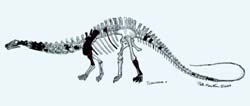Penn Researchers Describe Newly Found Dinosaur of the Montana Coastline

Credits: University of Pennsylvania
Through the cycads and gingkoes of the floodplains, not far from the Sundance Sea, strode the 50-foot-long Suuwassea, a plant-eating dinosaur with a whip-like tail and an anomalous second hole in its skull destined to puzzle paleontologists in 150 million years. According to researchers at the University of Pennsylvania, Suuwassea emilieae (pronounced SOO-oo-WAH-see-uh eh-MEE-LEE-aye) is a smaller relative of Diplodocus and Apatosaurus and is the first named sauropod dinosaur from the Jurassic of southern Montana. Their findings currently appear in the journal Acta Paleontologica Polonica
“Suuwassea is the first unequivocal new sauropod from the Morrison Formation a 150-million-year-old geological formation extending from New Mexico to Montana in more than a century. It has a number of distinguishing features, but the most striking is this second hole in its skull, a feature we have never seen before in a North American dinosaur,” said Peter Dodson, senior author and professor of anatomy at Penn School of Veterinary Medicine and professor in the Department of Earth and Environmental Sciences. “While its Diplodocus relatives have a single hole on the top of the skull related to the nasal cavity, paleontologists have yet to come up with a plausible use for this second hole.”
The name Suuwassea comes from the Native American Crow word meaning “ancient thunder” and also a nod to “thunder lizard,” the original nickname of the dinosaur now known as Apatosaurus. Emilieae is a reference to the late Emilie deHellebranth, whose financial support funded the dinosaur excavation.
The dinosaur skeleton was initially found by William Donawick, an emeritus professor of surgery at Penn School of Veterinary Medicine, while horseback riding with his son-in-law Will Tillett near the family ranch in Wyoming, close to the southern border of Montana.
At the time Suuwassea was alive, this part of the Morrison Formation was near the shoreline of a long but shallow arm of ocean water called the Sundance Sea. The coastal ecosystem has not been the typical environment for Morrison Formation dinosaurs, which have mostly been found in a more arid region farther south. The discovery of this new species could suggest that the fauna of this area differed from the rest of the Morrison Formation or that this region was something of a lush Jurassic vacation spot.
Nowadays, the region is much more arid, and much of Suuwassea partial skeleton was found exposed on the surface, from years of wind and rain erosion. The partial skeleton, which was deposited randomly by river flooding before fossilization, held enough distinguishing characteristics that Dodson and his colleagues could easily classify it as a new species.
“Suuwassea tail vertebrae are shorter and flatter at the ends than those of its relatives, and the proportions of some of the other vertebrae and leg bones are also different,” said Jerry Harris, coauthor and graduate student researcher in Penn Department of Earth and Environmental Science. “The extra hole in the skull is still a mystery; it has only been seen before in two dinosaurs from Africa and one from South America. It is interesting that the two African dinosaurs are exactly the same age as Suuwassea, and all three are also related to the much larger Diplodocus and Apatosaurus.”
Since the skulls of sauropod dinosaurs are largely made of thin, fragile bones, the researchers were fortunate to recover much of the skull at all.
“For sauropods, only the bigger, heavier and denser bones, like the limbs, are usually preserved,” Harris said.
Luck seems to be with the Penn researchers. Near the excavation site of the Suuwassea remains, members of the expedition chanced upon the partial skeleton of a new dinosaur predator, currently under study by Penn researchers.
Funding for this research was supported by Emilie deHellebranth; Penn Research Foundation, School of Veterinary Medicine and Department of Animal Biology; and the Penn Paleobiology Fund.
Suuwassea emilieae is currently in the collection of the Academy of Natural Sciences in Philadelphia, where Dodson is a researcher associate
Media Contact
More Information:
http://www.upenn.edu/pennnews/article.php?id=641All latest news from the category: Earth Sciences
Earth Sciences (also referred to as Geosciences), which deals with basic issues surrounding our planet, plays a vital role in the area of energy and raw materials supply.
Earth Sciences comprises subjects such as geology, geography, geological informatics, paleontology, mineralogy, petrography, crystallography, geophysics, geodesy, glaciology, cartography, photogrammetry, meteorology and seismology, early-warning systems, earthquake research and polar research.
Newest articles

Parallel Paths: Understanding Malaria Resistance in Chimpanzees and Humans
The closest relatives of humans adapt genetically to habitats and infections Survival of the Fittest: Genetic Adaptations Uncovered in Chimpanzees Görlitz, 10.01.2025. Chimpanzees have genetic adaptations that help them survive…

You are What You Eat—Stanford Study Links Fiber to Anti-Cancer Gene Modulation
The Fiber Gap: A Growing Concern in American Diets Fiber is well known to be an important part of a healthy diet, yet less than 10% of Americans eat the minimum recommended…

Trust Your Gut—RNA-Protein Discovery for Better Immunity
HIRI researchers uncover control mechanisms of polysaccharide utilization in Bacteroides thetaiotaomicron. Researchers at the Helmholtz Institute for RNA-based Infection Research (HIRI) and the Julius-Maximilians-Universität (JMU) in Würzburg have identified a…



